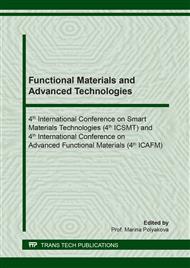p.24
p.32
p.37
p.42
p.49
p.57
p.67
p.75
p.82
Synthesis of Porous ZnO Films on Quartz Substrates by Thermal Oxidation and the Oxidant Atmosphere Effect
Abstract:
The synthesis and characterization of porous ZnO films using a two stage process by thermal oxidation using a bilayer precursor film (ZnO/Zn) consisting of a Zn film covered with a ZnO nanofilm formed on quartz substrates is reported. The Zn films of 50 nm were grown by DC sputtering method at 300K. In the first stage bilayer precursor films (BPF) of ZnO/Zn were produced by growing a ZnO nanofilm on Zn films by thermal oxidation at 350 °C by 30 min in N2 atmosphere containing 5 ppm of O2, and in the second stage the BPFs were oxidized at 800 °C for one hour either in dry N2, dry or wet air with 42% of humidity. The produced porous ZnO films were characterized by X-ray diffraction (XRD), scanning electron microscopy (SEM) and UV-Vis spectroscopy measurements. The results revealed the role of the oxygen content and the relevance of the humidity content in the processing atmosphere. When the BPF was oxidized in N2 with low oxygen content nanoporous ZnO films of wurtzite phase with its c-axis perpendicular to the plane of the substrate were produced. When rich oxygen content oxidation atmospheres were used, either in dry or wet air, nanoporous ZnO films with three main crystallite orientations (100), (002) and (101), were produced. The optical transmittance characteristics at the band edge region were strongly influenced by the humidity content but induce the formation of reproducible nanoporous ZnO films with sizes of ≈ 10 nm.
Info:
Periodical:
Pages:
49-54
Citation:
Online since:
March 2020
Keywords:
Price:
Сopyright:
© 2020 Trans Tech Publications Ltd. All Rights Reserved
Share:
Citation:


